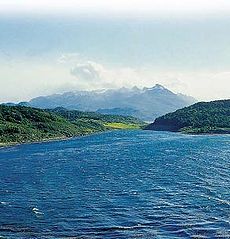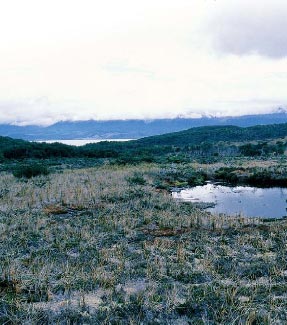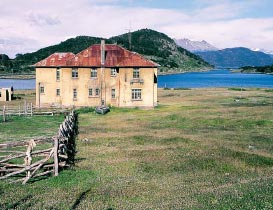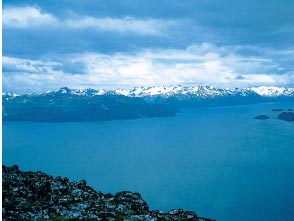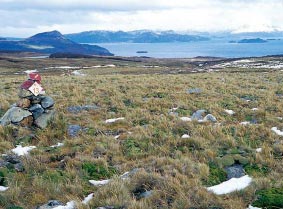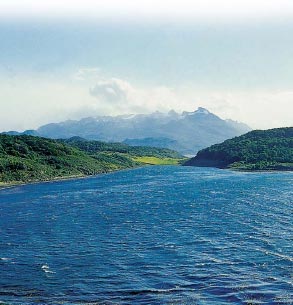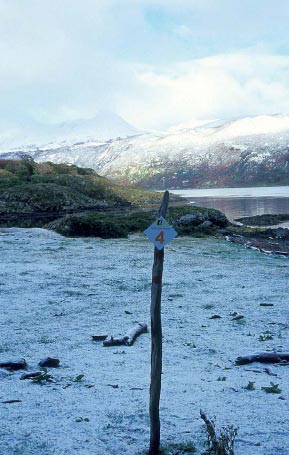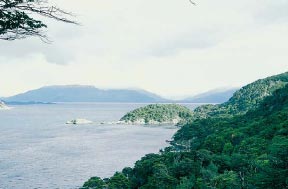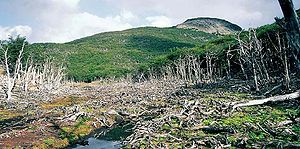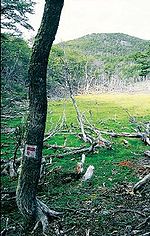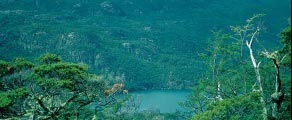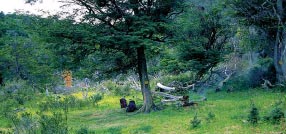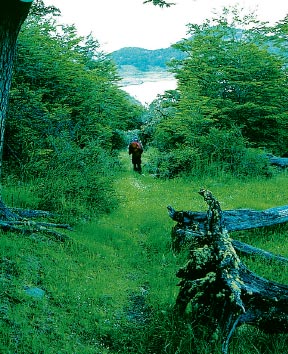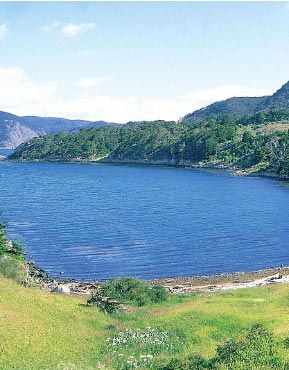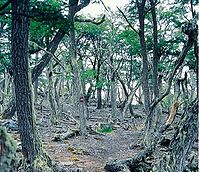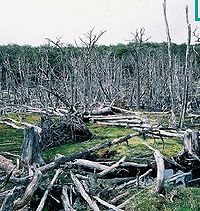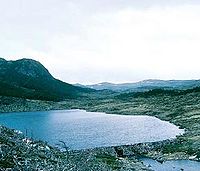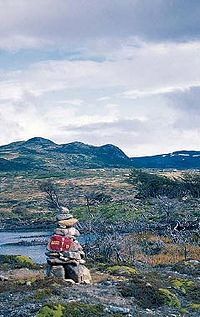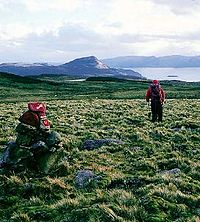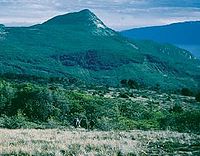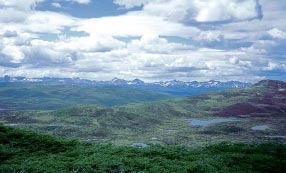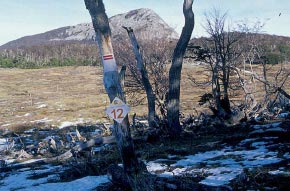Wulaia Heritage Road is a tour by 7000 years of history of the beautiful Wulaia bay, the land of the old Yámanas, a nomad almost extinct canoeist people, and the scenario of meetings and disputes between Yámanas and Europeans, since late the XIXth century: Darwin started here his reflection on the evolution of the species. The Yámana culture was developed under this sky. The Yámana Jemmy Button went on board of an English ship in this coast. Fitz Roy navigated these channels... Walking by this route means getting impregnated with myth and reality of Tierra del Fuego and its natural beauty that is unique in the world
Season
November to March
Location
The Heritage Road Cape Horn - Wulaia is located in Navarino Island, district of Cape Horn, Antarctic Province pertaining to Region XII of Magallanes. It is located in the north- east end of the island, in Beagle Channel's south bank, 10 nautical miles from Usuahia, and 55 kilometers from Puerto Williams, the district capital and main urban community of Tierra del Fuego's south coast.
Access
Land access is made through road Y- 905, 55 Km from Puerto Williams. Although it is open at all times, it only connects Puerto Williams to Puerto Navarino. It is a dirt road to Lum and from there to Wulaia, a signed and marked trail. Note that Puerto Williams is 300 Km from Punta Arenas, in Navarino Island, which can be reached by plane or boat.
Fishing boats regularly connect Puerto Navarino and Wulaia.
There is no regular transportation between Ushuaia and Puerto Navarino, only boats for rent that may take one to two hours in crossing Beagle Channel. Planes may be contacted to access Puerto Williams from Ushuaia.
General Description
Wulaia Heritage Road is located in the north-east sector of Navarino Island, a few kilometers to the north of Cape Horn. This is the third Heritage Road implemented in Navarino Island, following Dientes de Navarino and Lago Windhond Routes, each of them as described in their respective Topoguides. This pedestrian route system travels 150 Km of paths discovering the different landscapes and vegetation systems existing in Tierra del Fuego's south. This new route makes a tour through 7000 years of history available to trekking fans.
Depending on time available, physical condition and enthusiasm, the visitor can modulate his/her tour and customize his/her circuit with walks lasting from 1 to 6 days.
In Yamana language, Wulaia means beautiful bay and has been for thousands of years the historical capital of Tierra del Fuego. It is easy to see dozens of old Yamana camp sites that account for the beauty of the place. Here, in Wulaia, historical events took place, meetings and disputes, between Yamana and European civilizations.
Here is where Jemmy Button's story took place, the Yamana that was taken to and from England by Fitz Roy to be civilized, and who played later, in 1939, a significant role in the slaughtering of the 8 English missionaries. Charles Darwin also started here his thinking about evolution of the species. Late XIXth century, Wulaia was the place chosen by two Croatian gold hunters to settle a range dedicated to sheep farming, transforming thus the environment of the place. Now, a majestic abandoned construction (a radio station built in 1931) talks to us about the efforts made by the Chilean Republic to exercise sovereignty even in the last corner of this territory. But today, Wulaia is about to become a modern Archeological Park.
Walking to Wulaia is equivalent to submerge oneself into Tierra del Fuego's myth and reality, into a unique nature in the world, its millenary history and its untemporal beauty.
Wulaia Heritage Road is divided into two main circuits: Puerto Navarino-Wulaia and Lum -Wulaia. Both of them connect Beagle Channel's coast to Wulaia and allow to start walking by any of them and go back to the north by the other. These two circuits are added an extension to King Scott mount, called Wulaia-King Scott mount.
The 29 km Puerto Navarino- Wulaia circuit, lasting from 2.5 to 3.5 days, follows the coast facing Tierra del Fuego's vigor and natural beauty, both by land and ocean, comprising a number of sites where Yamana indigenous people installed their camps.
The 18.3 km Lum-Wulaia circuit, lasting from 1 to 1.5 days, goes through plentiful coast forests to discover the charm of low vegetation valleys, where the wind feels free to blow in the apparently wasted immensity of Cape Horn.
The 18.6 km and one day duration Wulaia King Scott mount extension (from and to Wulaia) provides an opportunity to easily reach the lonely peak on the shores of the sea that is crowned at 600 meters of altitude. The panoramic view provided over Tierra del Fuego archipelago will leave unforgettable memories.
We recommend to walk this route from December to March, however, it can also be traveled from October to November and from April to May, noting that snowfalls may be encountered in high sectors.
Signaling
The signaling system is made up by Arabic numbers which have their own meaning described in this Topoguide. The road comprises 29 MILESTONES and a number of route and direction indication marks, using rock monoliths, wooden stakes and trees. MILESTONES are geographically referenced according to Datum P. South-Am. 69. In addition, you will find among them a number of marks that help orient visitors.
In the first circuit Puerto Navarino-Wulaia, marks consist of a red horizontal line on a white or yellow rectangular background. In the second circuit Lum- Wulaia: marks are a double yellow horizontal line on a red rectangular background. Finally, marks of the extension to King Scott mount are presented as in the first circuit Puerto Navarino-Wulaia.
Track 1
Route description
The Puerto Navarino-Wulaia circuit is one of the alternatives proposed to connect Beagle Channels shore and Navarino Island coast with Wulaia. It is 29 km long and requires a 14 hour walk, that is, three or four days, depending on the rhythm of the walker.
The raid will take you by a landscape surrounded by all-sea panoramic views and will show you important archeological heritage vestiges of Navarino Island. This is an impressing tour for its closeness to the sea and permanent vision of the horizon full of peaks and mounts.
The circuit has been divided into 4 segments, with more tour alternatives, depending on your own rhythm, physical condition and weather conditions. It takes place mostly in the coast providing thus the opportunity to observe splendid and diverse vegetational groups. A number of archeological sites of the 7000 year-old Yamana nomad-maritime race enrich the tour and can be seen at a glance.
The first Puerto Navarino- Puerto Isorna segment is an interesting tour that follows Murray channel coast. In sectors lacking of protection, you can feel the strength of the wind that makes you remember that you are in the end of the world. Leaving Beagle Channel coast, follow Murray channel coast, that separates Navarino Island from Hoste island.
The second Puerto Isorna- Puerto Inútil segment takes place in the interior sector of a valley by a difficult trail that leads to Puerto Inútil.
The third Puerto Inútil- Caleta José segment is a magnificent tour by the west coast of Navarino Island surrounded by extremely beautiful and exuberant forests. Caleta Josés beach is a great place to camp.
Finally, the fourth Caleta José-Wulaia segment is a walk by a coast trail of an extreme beauty with impressing panoramic views and lands made up by pasturelands, forests and peat mosses. For all public.
First segment
PUERTO NAVARINO - PUERTO ISORNA
- Distance: 7,3 km.
- Walking Time: 3 hr.
Walk by the old coast trail, really beautiful and diverse forests. Large views of the Murray channel and Sampaio Mount range (Hoste island).
It starts in the sector of Puerto Navarino. Passing behind the Harbor Masters Office, in the middle of the thickets, you will find the trail to be followed to the west. Although this point is not represented through a mark or MILESTONE, it can be easily detected because it coincides with Harbor Masters Office and dock facilities. This point has been considered as kilometer zero.
You must always follow the strip that goes between the coast and the high forest. There are many trails marked by constant passage of cattle, but the ideal trail is always within 200 m of the coast.
The route recovers an old horse trail that resulted from the installation, late XIXth century, of the first cattle settlements in the island, in Liwaia and then in Puerto Navarino. It is still possible to observe remains of old and large fences or yards which are amazing for the huge work needed for their construction.
Clear and clean water supply sources are scarce in this first part. We recommend you to collect water in the river located 100 m before the houses of Puerto Navarino.
Leaving Puerto Navarino behind, walk 40 minutes through thickets of Mata Negra and Calafates to a wide plain covered with grass. Liwaia is located on the shores of the rivulet, as well as GUIDEPOST 1, 1,636 m from Puerto Navarino. A beautiful peninsula is detached in this sector over Beagle Channel.
Liwaia is a beautiful and cozy place, but not fit for camping. The rivulet is dry in the summer and the terrain is not protected from winds. Leaving the peninsula, to the right, and longitudinally crossing the clear plain, follow to the second beach located to the west. Turn here and go up to the left and enter again to the thicket to follow the coast.
It is common to find cow and pork cattle. Although they barely perceive human presence, you better not surprise them and make noise to announce your presence and give them time to run away. Females with offspring may be aggressive. In this extreme case, there is only one solution: running to the closest tree or rock.
From GUIDEPOST 1, keep going by the pastureland to the west until starting a soft decline to a beach. To the left (south), there is a stake indicating one of the many trails that get into the thicket sector. Follow the trail marked by animals and do not get away from the coast. 40 minutes later, you will fond the remains of an old fence made of trunks that ends in the sea. 60 metros before reaching the sea, you will find GUIDEPOST 2, a stake attached to the fence that indicates the end of the thicket and the entry to the forest. From here, follow the stakes that mark a zigzag route until arriving to a high forest.
The trail no longer borders the Beagle coast and changes the direction to follow Murray channel coast in a north-south axis. As it gets closer to Murray channel, you can see the highest forest of Cinnamon trees and Coigües. You can observe evident impact of wind in their growth.
After GUIDEPOST 2, keep going by the line of stakes that zigzags among small forests before getting into their luxuriant growth. From the vegetational point of view, this is a very attractive segment for its individuals of Notros, Lengas, Cinnamon trees, a shrub-like stratum of high development with representation of Calafates, Sarsaparillas, Michay and Species of Myrtle.
Openings and forests go one after the other until a brief descent to a beach covered by pasturelands and shelly deposits, at the height of a tiny woody that protrudes to Murray channel. Follow the pastureland to the south and after a brief passage by the forest, to a place known as Puerto de Hambre: GUIDEPOST 3. This is a gorgeous place to camp, although water is scarce in the summer.
Few meters away from the remains of a yard, there is a small water jet. Be patient to fill up a container. There is a lagoon 100 m inland, in a clear plain in the middle of the forest, but water is stagnant and turbid in the summer. Therefore, it has to be boiled before consumption. The closest and safest place to obtain water is Puerto Isorna, after a 50 minute walk.
From GUIDEPOST 3, go to a mark located in the other end of the small pastureland to get in the forest. After several ups and downs, alternating forests and beaches, even a stony sector where attention must be paid so as not to fall down, you will arrive to a huge plain of grass on the shores of the sea. This is Puerto Isorna. The start is GUIDEPOST 4, a beautiful beach and a great place to camp, although it lacks of trees protecting from the rain. We recommend you to install the camp near the MILESTONE, on the brink of the forest, in the sector of the bonfire. The river that flows into the sea, to the south of the MILESTONE, will provide abundant water. To enjoy charms of Murray channel coast, when you walk by the surroundings, you will see spectacular views of the channel. A splendid mirador is located at one hour from Puerto Isorna in the following position of coordinates UTM 542962 E and 3908925 N.
Second segment
PUERTO ISORNA - PUERTO INÚTIL
- Distance: 9,9 km.
- Walking Time: 5 hr, 45 min
- Dificulty: Medium
Walk by a trail covered with thickets and forests, following the coast by a narrow passage between the shore of the sea and the steep hill. A dense forest comprising Lengas, Coigües, Calafates, Notros and Cinnamon trees, reaches a significant development. Observation of guanacos. For all public. Medium difficulty level. Interesting ancestral shelly deposits. Proper for camping sites.
Description of the Section: After GUIDEPOST 4, cross the entire extension of the pastureland and wade through the river near its outlet into the sea. When you find the lowest water depth (in case of high tide, surround the hill to the inland and cross the river in the forest). At the opposite shore, climb some meters straight before turning to the left (east), turning your back to the sea.
After a short climbing, you will find a woody plain obstructed by the works made by the beavers. Turn to the left (north) and cross the river again in the opposite direction than in the previous crossing. After 60 m, turn to the right (east) and cross this semi- swampy plain always looking at the marks located in the opposite shore that indicate the arrival. Turn to the left (north) and follow the marks that indicate a new change of direction to the right (east), attacking the high gradient.
The path is characterized by a steep gradient in a quite dense forest. Pay attention to the marks so as not to miss the path. In spite of the zigzag-shaped nature of this long climbing, general direction is to the east. You may get out sometimes to reach a peak and enjoy magnificent panoramic views of the Murray channel, Sampaio mounts, and part of the Beagle Channel.
After two hours of an exhausting climbing, you will be happy to arrive to a forest free plain: here, you will find GUIDEPOST 5, hanging from a tree, near a clearing, indicating proximity to a great camping site, in the shores of Represa lagoon.
To get there, you have to climb by a small woody hill to the right (south), and from its opposite hillside, you will see an important beaver's dam indicating the end of Represa lagoon. The camping site is located at the entry of the forest, few meters to the right (south) of the dam. To get there, border the plain that is opened at the other side of the hill or walk by the dam (depending on river conditions) to the forest .A bonfire will confirm you that you have arrived to the camp.
After GUIDEPOST 5, the route still has a zigzag shape through a dense forest. Therefore, pay attention to the continuity of the intense marking characterizing the sector. You will finally arrive to the last segment of a long climbing and you will start going down to Laguna del Medio, that have to be surrounded by the right side (south), without getting close to the shore. Before reaching its south-east end, you will encounter GUIDEPOST 6.
This MILESTONE, painted on a tree, is located few meters from Laguna del Medio shore. It is the only place where the circuit reaches the bank of the lagoon and is also an alternative to camp, although the land is often wet.
After GUIDEPOST 6, keep going by the south hillside of the valley that goes down to Puerto Inútil. Pay attention so as not to miss the track. South-east direction before changing again the course to the east during the last 30 minutes of walk. After having walked for 2:30 hours, you will get to the shore of a river, 50 m away from its outlet into the sea. GUIDEPOST 7 is on a highlighted tree, indicating arrival to the coast by a deep sea arm called Puerto Inútil. This is the only camping site in the sector. Do not cross the river in GUIDEPOST 7, turn to the right, getting close to the beach, where you will quickly arrive to a sector covered with grass that contrasts to the forest. At the upper part of the pastureland, in the middle of shelly deposits, there are a number of sites where you can install your tent. There are small sites near the forest, but the land is usually saturated with water.
Third segment
PUERTO INÚTIL-CALETA JOSÉ
- Distance: 4,9 km.
- Walking Time: 3 hr, 15 min.
- Dificulty: Medium
Walk by trail and land made up by pasturelands, forests, and peat mosses. For all public. Medium difficulty level.
After GUIDEPOST 7, turn to the right and cross the river. This is the toughest section of the segment. Keep walking by the coast of Puerto Inútil to Caleta José (GUIDEPOST 8). The route becomes rough with steep slopes and a lot of turns intended to avoid the most difficult parts formed by streams flowing into the sea. Pay attention to marks so as not to miss the trail. Warning: slippery floor when too humid or wet. Once you get closer to Caleta José (GUIDEPOST 8), terrain becomes easier, a more open forest and a better trail. This MILESTONE is located at the beginning of the clear plain and indicated the beach of Caleta José.
The last groups of guanacos may be found in these segments. You may observe them, if you are lucky. There are beavers across the island, as well as typical avifauna from Tierra del Fuego.
Fourth segment
CALETA JOSÉ-WULAIA
- Distance: 6,5 km.
- Walking Time: 3 hr, 15 min.
A trail that travels to the South through Lenga and Coigue forests, passing by some beaches where shelly deposits are abundant. Proper for camping sites.
This south direction segment starts in GUIDEPOST 8 and surrounds a magnificent coast most of the time. After leaving the camp, climb the hill to the right and follow the marks and stakes that will guide you through a small thicket of mata negra. A trail may be observed in the floor, which has to be followed to Wulaia, always bordering the coast. One hour away from Caleta José - GUIDEPOST 8 - you will find Micalvi river, as well as GUIDEPOST 9, in its north shore, which has to be crossed carefully. If the river is too swift, and crossing becomes extremely difficult, we recommend you the foot or peak of the stream following animal trails that mark a safer ford. From the sea, you can admire the beautiful cascade that rises a few meters down the circuit.
Following the coast to the south, the trail keeps going through a mixed forest of Lengas and Coigües, passing from time to time by beaches full of shelly deposits. Once you are getting closer to Wulaia, the forest changes to patches planted with new shoots with areas of pastureland or thicket. This is the clearing work trail that made the first settlers who stayed at Wulaia, late the XIXth century, and who fired the forests to allow the growth of shepherding prairies.
GUIDEPOST 10, on a rock, will indicate that you have arrived to Wulaia. After GUIDEPOST 10, cross Matanza river, at the outlet to the sea, and you will find thus the great plain of Wulaia, with a majestic view to the building of the old navy radio station.
This is the most emblematic site in relation to old and recent history of Tierra del Fuego. Made of bricks, until a few years ago, it was the only construction built in solid material to the south of the Beagle Channel. Following its abandonment, all what was contained inside was disassembled and robbed. It is today a huge and pitiful empty skeleton that fights against weather inclemency. Heritage value of this building is incalculable and the tremendous effort implied by its construction has not been the object of much research or documentation.
The big grassy plain is perfect for camping everywhere. The only protection from wind is provided by the house. We recommend you to camp next to the house, but it is possible to stay at the grandiose abandoned building of the former naval radio station. South side door is opened. Go to the next door using north side stairs, and the first room to the left may receive travelers with some comfort: a table, chairs, and a metallic drum which may be used as a stove-heater. The building does not have rest rooms and water must be taken from the river. Before you leave, provide some firewood for the next visitors.
Track 2
PUERTO LUM - WULAIA
Route description
This circuit connects the shore of Beagle Channel and the north coast of Navarino Island, with Wulaia. It is 18.3 km long and requires 8 hr of continuous walk. It corresponds to the old trail to get to Wulaia and its relief is a long 6 hour rise from Lum to Mladineo passage (650 masl), and then, a 2 hour way down to Wulaia.
Taking land configuration into consideration, the few good camping sites and walk times, we recommend you to travel this circuit in one day and a half. This circuit has two segments.
The first segment lasts approximately 2 hours and 30 m and goes through large extensions of thickets and beautiful forests, where you will often find beaver's dams. You may enjoy gorgeous views of the Beagle Channel and Ushuaia.
After an invigorating night under the shelter of the upper limit of the forest, starts the 5:15 hour long second segment. High vegetation suddenly disappears making way for high humid steppe almost free of trees. Soil is covered with different varieties of peat mosses blended to rush or gramineous species, or a number of outcrops of rocks, water, rivers or lagoons.
Those who know how to observe and decipher nature will be amazed by the vigor of animal and vegetable life of the sector.
In the highest part of the last segment, Mladineo passage crossing is incorrectly called Andean desert, where mineral is omnipresent. However, there are some discrete and fascinating manifestations of vegetation.
From here, you will observe majestic views of the south-west of Navarino Island, Ponsonby gulf and mysterious Hoste island.
In the last hour of walk, a high and very dense forest appears again as suddenly as it had disappeared at the beginning of the segment. When the route gets closer to the sea level, pasturelands and younger trees (patches planted with new shots) appear more frequently, remains of intentional burning at the end of the XIXth century, when sheep breeding was implemented in Wulaia to prepare prairies.
Finally, Wulaia, the beautiful bay of the Yamanas, a place full of history and connected with the paths to the peak of King Scott mount or to Puerto Navarino through the enchanted shores of the west, both described in this topoguide.
The level of general difficulty of this circuit is qualified as moderately difficult. Difficulties come from adverse weather conditions, the poor visibility of the second segment or its extension where there is no natural sheltered place.
It is important to state that between GUIDEPOST 6 and 14, the land is apt for camping, the rest is saturated with water and there is no shelter against wind or rain. In consequence, the only appropriate site for camping is at GUIDEPOST 6.
Finally, walkers who want to run this circuit in the opposite way of the description from Wulaia to Lum should consider that the relief configuration favors it: the climb from Wulaia to the Mladineo path has a duration of 2.30 hours and the descent to Lum will only take 4.30 hours. The total walking is 7 hours allowing to execute the road in only one day. Otherwise, count 4.45 hours from Wulaia to the GUIDEPOST 6 (a site to camp in the forest) and 2.15 hours to Lum.
First Segment
PUENTE LUM-CAMPAMENTO
- Distance: 6,6 km.
- Walking Time: 2 hr, 30 min.
Walk by an old trail surrounded by forests, thickets, pampas and peat mosses. A one-day tour is recommended. The start is a long way up from Lum ranch, passing by upper valleys of the island.
The bridge over Lum river and the neighboring homonymic estancia locate at 35,5 Km at the west from Puerto Williams, which could be reached through the road towards Puerto Navarino with any type of vehicle in less than one hour.
GUIDEPOST 1 locates at the side of the bridge. A stairs allows to pass above the enclosure. Follow the river edge and do not worry for the dogs which only mark your way. After 150 meters there is a high forest where marks show the start of a well-marked track on the floor. 20 minutes after a rivulet affluent of Lum river crosses the road. GUIDEPOST 2 locates at the other side.
This rivulet of crystalline water is the last of this type until GUIDEPOST 6 (2 hours more). In the rest of the section there are lots of rivers or rivulets, but with very turbid water (as a consequence of beavers and the peat). After GUIDEPOST 2 take a look at the marks that zigzag in the forest until seeing GUIDEPOST 3 on a tree marking the provisional finish of the forest and the entrance to a large underbush of Mata Negra and Calafate of one-meter height by reaching the next MILESTONE.
A very well-marked track follows the course of the Lum river, which runs to the right (west). A large isolated forest area shows the angle formed by the river to the right. Follow this direction to the posts signaling GUIDEPOST 4.
GUIDEPOST 4 shows a drastic change of direction and the abandonment of the track. In spite the fact the track goes straight, it is necessary to turn to the left (south), following the prominent posts from the underbush. Spines of Calafate and the absence of a marked track difficult the path, but it is a short section.
Soon a small rocky hillock is visible, surrounde it by the right and follow the little valley before take direction to the right, so as to reach a large high forest area that is distinguished by its trees with black dead truncks conforming the tiny lagoon of beavers that you will find soon and which should be surrounded by the left following the marks.
After this large forest area you go through a short clear section before penetrating a large forest. GUIDEPOST 5 locates at the entrance on a tree. 20 minutes have elapsed from the previous MILESTONE.
Between GUIDEPOST 5 and 6, pay special attention to marks. The road zigzags through the forest with no marked track on the floor with general direction to the south and mostly in ascention. After one hour of walking, numerous rivulets and beavers habitat sectors are crossed to finally find GUIDEPOST 6 on a tree.
GUIDEPOST 6 states the only site apt for camping at about one hundred meter from the final exit of the forest. It is important to consider that from GUIDEPOST 6 to Wulaia (at 11.5 Km or 5.30 hrs. after walking) the land is not apprpopriate for camping due to the absence of forest or natural shelter against wind or rain. In addition, the soil is saturated with water or rocks.
The good visibility is essential to guide on the wide valley that follows to the Mladineo path. Evaluate the possibility to continue the tour or spend the night and continue the day after.
Second segment
CAMPAMENTO-WULAIA
- Distance: 11,5 km.
- Walking Time: 5 hr, 15 min.
Walk by a forest-free geographic scenario, following the trail of Matanza valley. Lack of natural protection. Passing by the bottom of Vrsalovic hill, panoramic view of Ponsonby Gulf, Pacha and Mascart islands, Tortuga mount, and King Scott mount.
This section begins in GUIDEPOST 6 from where you should follow some hundred of meters until suddenly exit the forest. Posts mark the south, a climb allows to reach a plain where you should surround a lagoon and then left it at the left side (east). Soon, a second lagoon at the right hand (west), where GUIDEPOST 7 locates at the edge on a small hillock on a MILESTONE of stone.
Pay attention because at 150 m to the southeast from GUIDEPOST 7, on an islet forming a perfect conical hillock a highlighted post arises which is noticed at a distance. It is a sign that enables to locate GUIDEPOST 7. The walker should continue (south direction) through the posts with the same marks that have been followed until this point.
After GUIDEPOST 7 follow the posts to the south before turning to the right and then to the left. In 15 minutes you will get to a stone MILESTONE conforming GUIDEPOST 8. From here, the land guide steps to GUIDEPOST 11. It is a path through a wide valley lacking of high vegetation and full of small lagoons, streams and beavers lagoons. From GUIDEPOST 8, an extended sight can be appreciated to the south. If an imaginary line is traced in that direction three prominent elements can be observed:
1. At the left side (east), a solitary mount ending in a hillock, the lowest of the three hillocks conforming the peak: It is Vrsalovic mount, which should be surrounded by the right. GUIDEPOST 9 locates at the foot thereof.
2. At the south, to the west end of the Vrsalovic mount, the horizon closes with a line of undulatory peaks, a mountain chain from east to west. In the middle, Mladineo path is observed, GUIDEPOST 11 locates there.
3. In the lower half to the Mladineo path, a simple view with good light, a huge black and square rock is noticed at 200 m to the right (west). There is GUIDEPOST 10, where marks take their habitual frequency again.
With direction to the feet of Vrsalovic mount you will leave GUIDEPOST 8 with direction to the south and you will be guided by the instinct to find the best crossings between rivulets or water bodies that are all over the place. In the middle of the road, between GUIDEPOST 8 and the feet of Vrsalovic mount, a stone MILESTONE on the peak of a small hillock shows the position of GUIDEPOST 9. If you have followed the imaginary line, then this MILESTONE should be at the left of the walker.
Move forward between waters and rocky hillocks, you will reach to the surroundings of Vrsalovic mount, where there is a pretty large lagoon which should be surrounded by the right to find a three meter post showing GUIDEPOST 10.
GUIDEPOST 10 shows a point to the west of the lagoon located at the foot of Vrsalovic mount, from here the previously mentioned black rock is clearly noticed. At a short distance to the right (west) there is a smaller rock on which you could even distinguish the white color conforming the background of the MILESTONE mark. Take the climb strongly inclined to reach 40 minutes later to GUIDEPOST 11.
GUIDEPOST 11 shows a middle point on the climb of the Mladineo path. Until moving downwards to the other side of the Mladineo path all marks are MILESTONES of stones. Between GUIDEPOST 11 and 12 you could turn around and enjoy the beautiful sight above the Beagle and Ushuaia channels. Cheer up from now to Wulaia, the road is downwards.
After GUIDEPOST 11, continue climbing through stone MILESTONES during 30 minutes following a south direction until GUIDEPOST 12 which shows the position of the Mladineo path and the end of the climb.
A few meters after the peak of the path and GUIDEPOST 12, an abrupt rocky descent opens under which you could perfectly distinguish the stone MILESTONE showing the following MILESTONE at the beginning of the reappearance of the vegetal layer.
Before the descent enjoy the wonderful sight: to the south the Tortuga mount (836 m.a.s.l.) and its two peaks in the form of smashed hillocks state the southwest corner of the Navarino island; to the southwest, a solitary peak near the sea in King Scott mount (590 m.a.s.l.), accessible through a path that commences in Wulaia. Ponsonby bosom opens to the west surrounded by the mountains of the Hoste island. Pacha and Mascart islands highlight in the center. In the same axle, but invisible from this point is Wulaia and the end of the path.
The next 3,3 kilometers of the section to the last descent in the forest over Wulaia at the foot of the path a wide valley opens which should follow to the sea, namely to the west, keeping the left side (south) of the valley.
From GUIDEPOST 12 follow the marks with south direction being careful with the loose rocks of this abrupt descent. 30 minutes of walking through the vegetation of diverse mosses is a stone MILESTONE showing GUIDEPOST 13. The feet of the Vrsalovic path on its south hillside and a change of direction to the (southwest), where the descent of the valley begins until entering the forest.
From GUIDEPOST 13, a series of stone MILESTONES will guide your steps until crossing the river. Then, although there are no marks during half an hour, keep the same direction between tiny areas of forest to the left (south) and the river which has just forded at your right (north). Afterwards, high posts appear showing the road until a descent, here a short forest section crosses followed by the crossing of the Matanza river. At a few meters after fording the river, GUIDEPOST 14 indicates the entrance to a forest and the beginning of the last section of this path, which develops inside the forest and with a strong slope downwards. Follow the marks for not losing the track. One hour of walking and you will be at the exit of the forest. GUIDEPOST 15 locates over a door gate for livestock, 200 m through the pastureland having at sight the old former radio station from Wulaia.
Alternative Extension
WULAIA - MONTE KING SCOTT
- Distance: 9,3 km.
- Walking Time: 3 hr, 30 min.
Segment of medium difficulty at the end, where the trail goes by deep cliffs. Ascension to King Scott mount. Spectacular panoramic view of sites where guanacos have lived from ancestral times and can still be seen today.
Route description
As an extension of the PuertoNavarino Wulaia circuit, this brief section transits through one of the most marvelous beauties from Tierra del Fuego awaking the curiosity of walkers who arrive to Navarino island. You will reach the peak of the King Scott mount, a well-known MILESTONE of the trekking that is acceded in one day to enjoy the most beautiful panoramic views on the south of the Tierra del Fuegos archipelago.
Its length is 9.3 Km, 3.30 hours with a difficult level qualified as moderately difficult due to the climb to the peak from the southeast, being an ascension easier than the vertiginous walls observed from Wulaia. The marking is equal than the one used in Puerto Navarino-Wulaia (a double red line on a rectangular white or red background) and the numbering follows the correlative order.
From the peak of the King Scott mount, you will have the opportunity to observe and discover, the geographybeyond the Murray channel. The vision embraces an extension of 120Km from north to south and 90 Km from west to east. The tour includesbeaches, beautiful coastal, interior and height forests, large peat mossesand beavers habitat sectors.
===First Segment=== The tour begins at the former radio station from Wulaia (GUIDEPOST 10). Then you will cross a pastureland where you will notice a number of large areas of shells used by the old Yámanas inhabitants as a shelter for winter time. At the other end, a clear track is distinguished that climbs the hillside of a hillock. Follow this track and surround the coast during 45 minutes until GUIDEPOST 11 located on a tree at a few meters after a small river.
The section between GUIDEPOST 11 and 12 (1.20 hours of walking for 6 Km on an uneven surface of 340 m) allows to arrive to a higher plain surrounding the east of King Scott mount. It is not a constant slope, it appears in the form of steps. The climb towards the beginning of the peak is strong, but short: 160 m of unleveled surface in 500 m (30 min. of walking). The last 10 min. at the rocky part of the peak require precaution for the precipice that opens at the west side (there is enough distance to keep far from the precipice).
GUIDEPOST 11 indicates a change of direction to the east and the start of the ascension to the feet of King Scott mount. You will pass through small forests of Coigües and Lengas, which will later lead to Mata Negra, Calafate, Chaura and some isolated species of Notros and firewoods.
Follow the marks that cross a sector of forest which slowly becomes more clear until leaving vast pasturelands where Bulrush and Frutilla del Diablo develop in the areas of highest humidity. After following a hillside through a well-marked track, enter the forest again and follow with attention the marks showing a soon change of direction to the right (south), facing in certain sections very inclined slopes. The alternation of forests and peat mosses conclude in a wooded hillock which suddenly offers a clear sight of the large upper plain at the east of the King Scott mount.
GUIDEPOST 12 locates on a tree at the edge of the forest showing the exit and the start of the plain before the ascension of the mount. King Scott mount elevates to the right. Its proximity is real, but a deep stream and a sector of lagoons, invisible from there, do not allow to reach it in straight line.
The forest of the hillock before GUIDEPOST 12 offers a good place for camping with a rivulet at 100 m. Immediately after GUIDEPOST 12 follow the series of posts crossing the peat, which turn to the left. Do not enter forest sectors.
Pay attention to the posts showing the road, especially in the middle of the section dominated by bulrushes.
The start of the valley that justifies this long detour to the left is at the right.
By getting closer to King Scott mount, there is an opening of a plain with lagoons and a spreading forest particularly damaged by beavers and forcing to zigzag between these obstacles. You should identify the marks leading to edges of the forest (GUIDEPOST 13), which covers the last slope towards the peak of the King Scott mount.
This GUIDEPOST 13 on the edge of the forest indicates the start of the final ascension to the peak that is moderately difficult and depends on soil humidity. Enter the forest and Iet you guide by a particularly dense marking through a very inclined slope. In the event the soil is saturated with water, most abrupt sections are very slippery and could cause serious risks of fall.
Upon exiting the forest follow the tracks of the guanacos in the middle of rocks to the right. A stone MILESTONE shows the highest part of the peak of the King Scott mount (GUIDEPOST 14). Wind gusts could be very violent here. You should cover your personal items (cap, gloves, even cameras, etc.) King Scott mount is a fortress protected almost all along its perimeter by vertiginous precipices or deep streams.
If you have reached the peak of the King Scott mount ¡Congratulations! Now, enjoy the sight:
- To the north and downwards Wulaia (the former radio station is in the middle of the pastureland).
- Following the coast to the north of Wulaia, the narrow entrance of Puerto Inútil.
- To the north of Puerto Inútil, a small part of the Beagle channel and at the northern coast Ushuaia. The hills behind Ushuaia are Martial mounts. Olivia mount is sharp and the most elevated at the right of Ushuaia (1476 masl)
- To the left of Puerto Inútil, the highlighted Button island and at the east 14 de Julio bay. - Immediately to the left of the Button island the Murray channel that separates Navarino (to the east) island with Hoste island (to the west) is clearly observed.
- Dumas peninsula starts from the Hoste island to the left of the Murray channel. On its south top, the closest to the King Scott mount you could see with binoculars a house at a few meters from the sea: It is Tasuani, an old estancia currently abandoned.
- At the west you will see the opening of the Ponsonby deep bosom which separates Dumas (at the north) and Pasteur (at the south) peninsulas from Hoste island. In the middle and at the beginning you will observe first the Pacha island and a bit more to the right the Mascart island.
- The long Milne Edwards island locates in front of the snowy peaks of the Pasteur peninsula.
- The most distant line of land that is noticed to the south and that has continuity with the Pasteur peninsula is the Hardy peninsula of the Hoste island. Its location more to the south is called False Cape Horn.
- Always to the south over the Navarino island the Tortuga mount highlights with 836 m of height.
- To the left, towards the horizon, you could distinguish a thin line of land very far behind: It is the north of the archipelago of the Wollaston islands. Its last island to the south invisible from here is the mythical Cape Horn.
- To the left, returning to the Navarino island a mountain chain is distinguished with north-south axle: They are the Codrington mounts.
- Short far away you could observe the sharp chain of Dientes de Navarino, at the back of Puerto Williams.
- Near Wulaia you could distinguish the Mladineo path and the descent of the Lum-Wulaia path on Wulaia. The peak is totally exposed to the gusts that could be very violent; you should take that for granted and take all precautions.
To return to Wulaia you should take the same road. The start of the descent is in the forest to MILESTONE 13, try not to slide. From the peak of the King Scott mount to Wulaia consider 2.45 hours of walking.
Recommendations
Basic:
- Try to do a tour in company and well informed.
- Consider the duration of sections so you are not caught by night.
- Take into consideration the changing weather conditions.
- Move only through the market road. Do not go far from track.
- Do not leave wastes in the nature, bring it back with you.
- Camp only in appropriate places and do not leave traces. Avoid fires, if there is no other choice extinguish fire with abundant water.
- Do not hunt or disturb the existing native fauna.
- Notify Carabineros of Chile when you leave and return.
It is necessary to bring :
- Thermal warm clothes and windbreaker.
- First aid kit.
- Provisions for at least a couple of days for possible contingencies.
- Map of the path and elements for orientation.
- UV glasses and sun protector cream.
Information required: *Weather conditions for a better planning of the tour.
- Condition of roads and tracks conforming the road in Carabineros of Puerto Williams, and also about the flow conditions of the main water courses crossing the road.
- This trekking is described in full detail in the following topoguide of the Ministery of Public Patrimony. The printed guide can be obtained for free in the Ministery:56-2-3512100 -> 2325. It is hihgly recommended to take it to the walk, as it enriches the experience with descrptions of flora, fauna, geography and geology.
|


